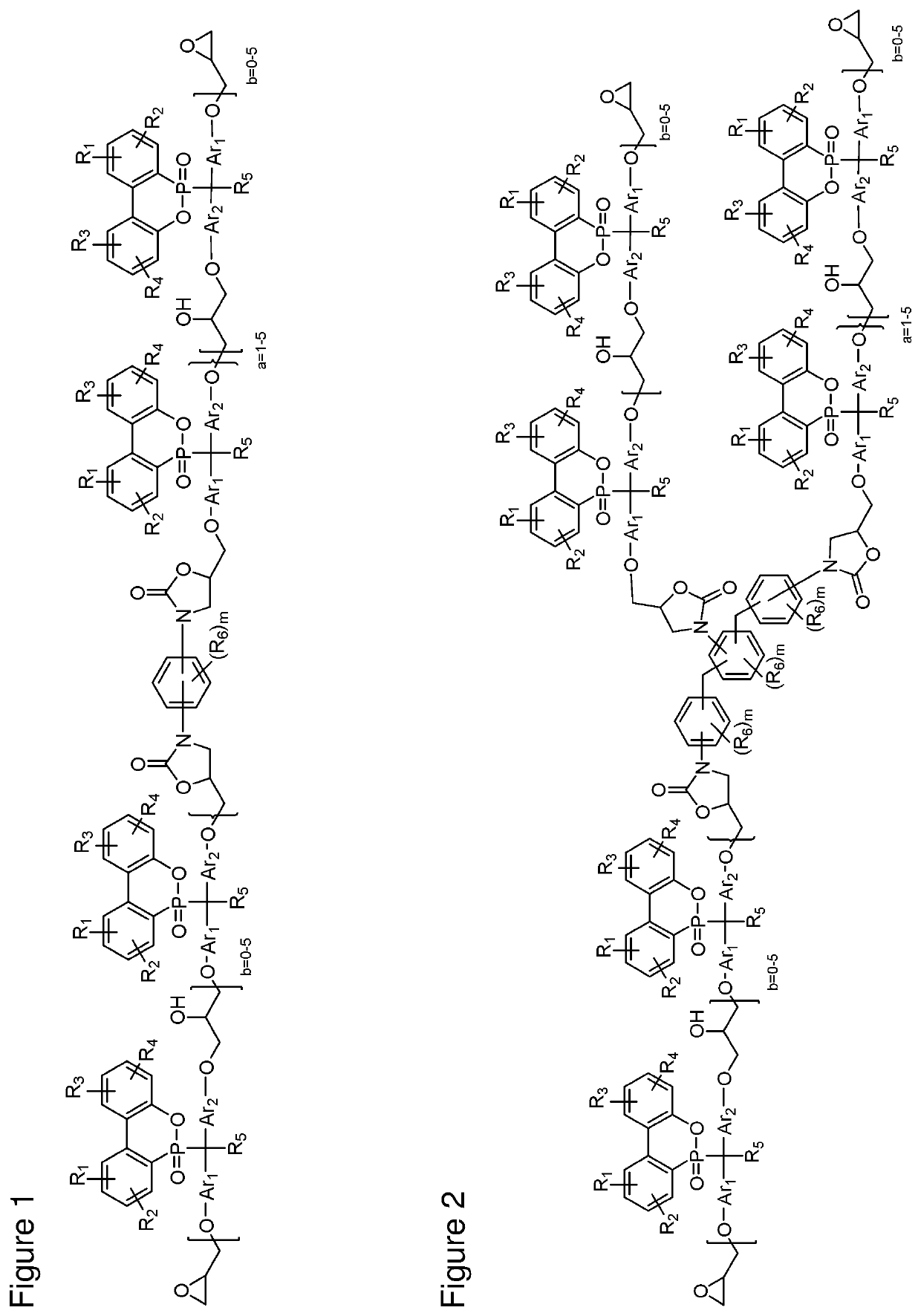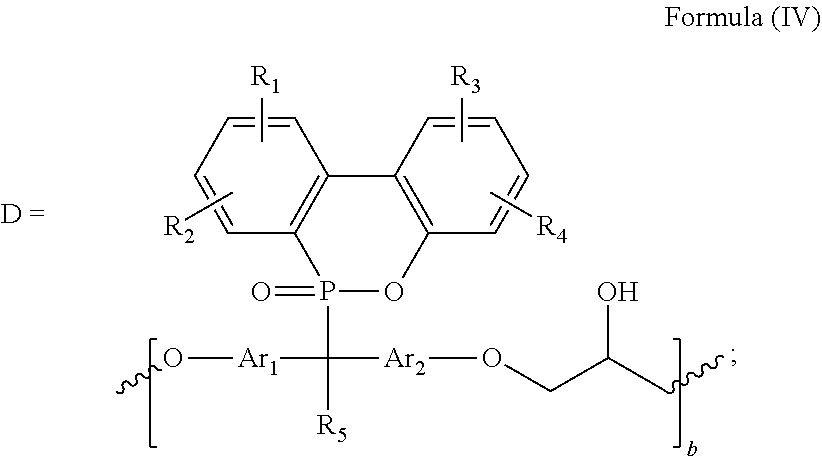Phosphorous containing epoxy resins and process for synthesis
- Summary
- Abstract
- Description
- Claims
- Application Information
AI Technical Summary
Benefits of technology
Problems solved by technology
Method used
Image
Examples
example 1
Synthesis of Phosphorus Containing Bisphenol Compound A1 (DMP)
[0198]
[0199]10.81 g (0.05 mole) of 9,10-dihydro-9-oxa-10-phosphaphenanthrene-10-oxide (DOPO), 23.5 g (0.25 mole) of phenol, 6.81 g (0.05 mole) of 4′-hydroxyacetophenone, and 0.432 g (4 wt % based on the weight of DOPO) of p-toluenesulfonic acid were mixed and stirred in a 250 ml three-necked flask reactor at room temperature in advance. The reactants were stirred constantly at 130° C. for 24 hours to form a mixture, and then the temperature of the mixture was cooled down to the room temperature. The crude products separated out from the cooled mixture were washed by ethanol and then filtrated and dried. The phosphorus-containing bisphenol product A1 (DMP), was obtained as a white powder.
[0200]The yield of the foregoing phosphorus-containing bisphenol was 85%, and the melting point was 306° C. The measured value of the carbon, hydrogen, and oxygen element were 72.48%, 4.65%, and 14.90%, respectively (the theoretical value,...
example 2
Synthesis of Phosphorus-Containing Bisphenol Epoxy 81 (DMPE)
[0201]
[0202]214 g (0.4 mole) of DMP (phosphorus-containing bisphenol compound A1) and 925 g (1.0 mole) of epichlorohydrin were placed in a five-neck glass reaction kettle equipped with an electric heating jacket, a temperature controller, an electric stirrer and a stirring bar, a nitrogen gas inlet, a thermocouple, a water-cooled condenser, and a feeding funnel. Nitrogen gas was introduced and the reaction kettle was heated to 130° C. After the DMP completely melted, temperature of the reaction kettle was decreased to 70° C. and then 200 g of 20% aqueous sodium hydroxide solution was added into the homogeneous solution at a constant rate over 4 hours and the water contained in the reaction system was azeotropically distilled at the same time under absolute pressure of 190 mm Hg. After the reaction had completed, the remaining epichlorohydrin and solvent were removed by vacuum distillation. Sodium chloride contained in the r...
example 3
Synthesis of Curable Compounds of Formula (I)
[0203]
wherein
[0204]100 g of DMPE (Example 2), (used as Formula(II), wherein b is 0-5, Ar1 and Ar2 are formula (XIII) wherein m is 0 and n is 0, R5 is methyl, R1, R2, R3, and R4 are H) was placed in a five-neck glass reaction kettle equipped with an electric heating jacket, a temperature controller, an electric stirrer and a stirring bar, a nitrogen gas inlet, a thermocouple, a water-cooled condenser, and a feeding funnel. The reaction kettle was heated to 130° C. under a nitrogen atmosphere. After the DMPE was completely melted and dried under vacuum, 0.5g of catalyst A was introduced under a nitrogen atmosphere. After the temperature was raised to 150° C., 7.9g of MDI1 (used as Formula (III), wherein A is formula (XVII) wherein m is 0) was added into the reaction. The temperature was elevated to 165° C. and the reaction was stirred for 1 hr. The product (Example 3), (used as Formula (I), wherein b is 0-5, Ar1 and Ar2 are formula (XIII) ...
PUM
| Property | Measurement | Unit |
|---|---|---|
| Temperature | aaaaa | aaaaa |
| Time | aaaaa | aaaaa |
| Time | aaaaa | aaaaa |
Abstract
Description
Claims
Application Information
 Login to View More
Login to View More - R&D Engineer
- R&D Manager
- IP Professional
- Industry Leading Data Capabilities
- Powerful AI technology
- Patent DNA Extraction
Browse by: Latest US Patents, China's latest patents, Technical Efficacy Thesaurus, Application Domain, Technology Topic, Popular Technical Reports.
© 2024 PatSnap. All rights reserved.Legal|Privacy policy|Modern Slavery Act Transparency Statement|Sitemap|About US| Contact US: help@patsnap.com










